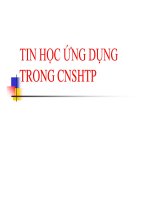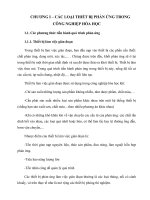Tin học ứng dụng trong công nghệ hóa học Parallelprocessing 3 abstractmodels new
Bạn đang xem bản rút gọn của tài liệu. Xem và tải ngay bản đầy đủ của tài liệu tại đây (584.67 KB, 26 trang )
Chapter 2
Parallel Computer
Models & Classification
Thoai Nam
Faculty of Computer Science and Engineering
HCMC University of Technology
Chapter 2: Parallel Computer
Models & Classification
Abstract Machine Models:
– PRAM, BSP, Phase Parallel
Pipeline, Processor Array, Multiprocessor, Data
Flow Computer
Flynn Classification:
– SISD, SIMD, MISD, MIMD
Pipeline Computer
Khoa KH&KT MT - ĐHBK TP.HCM
Abstract Machine
Models
Thoai Nam
Faculty of Computer Science and Engineering
HCMC University of Technology
Abstract Machine Models
An abstract machine model is mainly used in
the design and analysis of parallel algorithms
without worry about the details of physics
machines.
Three abstract machine models:
– PRAM
– BSP
– Phase Parallel
Khoa KH&KT MT - ĐHBK TP.HCM
RAM (1)
RAM (Random Access Machine)
Read-only
input tape
x1 x2
…
xn
r0
Location
counter
Program
r1
r2
r3
…
Memory
Write-only
output tape
x1 x2
Khoa KH&KT MT - ĐHBK TP.HCM
…
RAM (2)
RAM model of serial computers
Memory is a sequence of words, each capable of containing
an integer
Each memory access takes one unit of time
Basic operations (add, multiply, compare) take one unit time
Instructions are not modifiable
Read-only input tape, write-only output tape
Khoa KH&KT MT - ĐHBK TP.HCM
PRAM (1)
Parallel Random Access Machine (Introduced by Fortune and Wyllie, 1978)
Control
P1
Private memory
…
P2
Private memory
…
Private memory
…
…
Interconnection network
Global memory
…
Khoa KH&KT MT - ĐHBK TP.HCM
Pn
PRAM (2)
A control unit
An unbounded set of processors, each with its own private memory and
an unique index
Input stored in global memory or a single active processing element
Step: (1) read a value from a single private/global memory location
(2) perform a RAM operation
(3) write into a single private/global memory location
During a computation step: a processor may activate another processor
All active, enable processors must execute the same instruction (albeit
on different memory location)???
Computation terminates when the last processor halts
Khoa KH&KT MT - ĐHBK TP.HCM
PRAM(3)
PRAM composed of:
– P processors, each with its own unmodifiable program
– A single shared memory composed of a sequence of
words, each capable of containing an arbitrary integer
– a read-only input tape
– a write-only output tape
PRAM model is a synchronous, MIMD, shared
address space parallel computer
– Processors share a common clock but may execute
different instructions in each cycle
Khoa KH&KT MT - ĐHBK TP.HCM
PRAM(4)
Definition:
The cost of a PRAM computation is the product of the
parallel time complexity and the number of processors used.
Ex: a PRAM algorithm that has time complexity O(log p) using
p processors has cost O(p log p)
Khoa KH&KT MT - ĐHBK TP.HCM
Time Complexity Problem
Time complexity of a PRAM algorithm is often
expressed in the big-O notation
Machine size n is usually small in existing parallel
computers
Ex:
– Three PRAM algorithms A, B and C have time complexities
if 7n, (n log n)/4, n log log n.
– Big-O notation: A(O(n)) < C(O(n log log n)) < B(O(n log n))
– Machines with no more than 1024 processors:
log n ≤ log 1024 = 10 and log log n ≤ log log 1024 < 4
and thus: B < C < A
Khoa KH&KT MT - ĐHBK TP.HCM
Conflicts Resolution
Schemes (1)
PRAM execution can result in simultaneous access to the
same location in shared memory.
– Exclusive Read (ER)
» No two processors can simultaneously read the same memory
location.
– Exclusive Write (EW)
» No two processors can simultaneously write to the same memory
location.
– Concurrent Read (CR)
» Processors can simultaneously read the same memory location.
– Concurrent Write (CW)
» Processors can simultaneously write to the same memory
location, using some conflict resolution scheme.
Khoa KH&KT MT - ĐHBK TP.HCM
Conflicts Resolution
Schemes(2)
Common/Identical CRCW
– All processors writing to the same memory location must be writing
the same value.
– The software must ensure that different values are not attempted to
be written.
Arbitrary CRCW
– Different values may be written to the same memory location, and an
arbitrary one succeeds.
Priority CRCW
– An index is associated with the processors and when more than one
processor write occurs, the lowest-numbered processor succeeds.
– The hardware must resolve any conflicts
Khoa KH&KT MT - ĐHBK TP.HCM
PRAM Algorithm
Begin with a single active
processor active
Two phases:
– A sufficient number of processors
are activated
– These activated processors
perform the computation in parallel
log p activation steps: p
processors to become active
The number of active
processors can be double by
executing a single instruction
Khoa KH&KT MT - ĐHBK TP.HCM
Parallel Reduction (1)
4
7
17
3
8
10
2
9
10
1
0
5
5
15
32
6
9
9
9
41
Khoa KH&KT MT - ĐHBK TP.HCM
3
Parallel Reduction (2)
(EREW PRAM Algorithm in Figure2-7, page 32, book [1])
Ex:
SUM(EREW)
Initial condition: List of n 1 elements stored in A[0..(n-1)]
Final condition: Sum of elements stored in A[0]
Global variables: n, A[0..(n-1)], j
begin
spawn (P0, P1,…, Pn/2 -1)
for all Pi where 0 i n/2 -1 do
for j 0 to log n – 1 do
if i modulo 2j = 0 and 2i+2j < n the
A[2i] A[2i] + A[2i+2j]
endif
endfor
endfor
end
Khoa KH&KT MT - ĐHBK TP.HCM
Broadcasting on a PRAM
“Broadcast” can be done on CREW PRAM in O(1)
steps:
– Broadcaster sends value to shared memory
– Processors read from shared memory
Requires logP steps on EREW PRAM
M
P
P
P
S
…
P
Khoa KH&KT MT - ĐHBK TP.HCM
BSP – Bulk Synchronous Parallel
BSP Model
– Proposed by Leslie Valiant of Harvard University
– Developed by W.F.McColl of Oxford University
Node (w)
P
M
Node
P
M
Node
P
M
Barrier (l)
Communication Network (g)
Khoa KH&KT MT - ĐHBK TP.HCM
BSP Model
A set of n nodes (processor/memory pairs)
Communication Network
– Point-to-point, message passing (or shared variable)
Barrier synchronizing facility
– All or subset
Distributed memory architecture
Khoa KH&KT MT - ĐHBK TP.HCM
BSP Programs
A BSP program:
– n processes, each residing on a node
– Executing a strict sequence of supersteps
– In each superstep, a process executes:
» Computation operations: w cycles
» Communication: gh cycles
» Barrier synchronization: l cycles
Khoa KH&KT MT - ĐHBK TP.HCM









